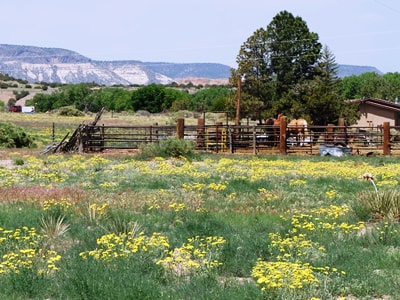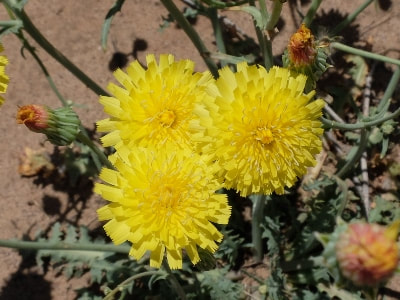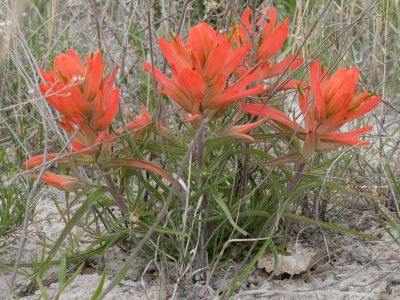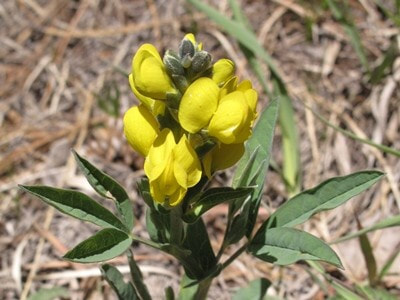Sowthistle Desert Dandelion, Yellow Saucers,Malacothrix sonchoides,Sunflower Family (Asteraceae)5/31/2024 The Bloom Blog Blooming this week in the environs of Abiquiú By Wildflowers of the Southern Rocky Mountains Found in dry, sandy areas
Seen blooming in May around Mamacita’s, Hwy 554 In the fields around Mamacita’s there is a super bloom of Sowthistle Desert Dandelions happening. Thousands of showy yellow flowers are brightening the smoky landscape. In the 12 years I have lived here I have never seen this before; must be right moisture at the right time. There is also an abundance of bright orange Globemallow blooming along the highways. Sowthistle Desert Dandelions grow to 14 inches high with smooth, leaning, twisted, branched stems and short, fleshy, lobed leaves growing in a rosette. Flower heads are dandelion-like with only ray flowers and are about one inch across. Individual petals are toothed at the tip. The Navajo used the plant for vomiting; unspecified whether to induce or cure. Source. If you are trying to identify a different flower then you can check what other flowers bloom this month. If you cannot identify a flower from the website, send a photo and where you took it to [email protected]. Read online for tips.
2 Comments
The Bloom Blog Blooming this week in the environs of Abiquiú By Wildflowers of the Southern Rocky Mountain By Marilyn Phillips
Found in dry, sandy, gravelly areas, in piñon-juniper woodlands Seen blooming in May off FS Road 23, Carson National Forest We have several species of Penstemon growing in our area. Some also have the common name of Beardtongue because of the long, hairy tongue that sticks out from the throat of the flower. This Penstemon grows to 14 inches high with many narrow lance-shaped leaves. Flowers and buds are very sticky and hairy and grow on one side of the stem. The flowers are lavender to violet with dark purple nectar guide lines. They are about ½ inch long with a wide, densely hairy throat and a curved tongue covered in yellow hairs extending from the throat. Traditionally the plant was used as an emetic and lotion to purify a newborn infant before nursing and a cold, compound infusion of plant was taken for headache and sore throat. Source. If you are trying to identify a different flower then you can check what other flowers bloom this month. If you cannot identify a flower from the website, send a photo and where you took it to [email protected]. Read online for tips. The Bloom Blog Blooming this week in the environs of Abiquiú By Wildflowers of the Southern Rocky Mountains Found in piñon-juniper and Ponderosa woodlands
Seen blooming in May in Red Wash Canyon This is one of several species of Indian Paintbrush that grow in our area. Orange Paintbrush can grow to 20 inches tall, typically less, with long, purplish-green, rolled leaves and hairy stems. What appears to be flowers, the paintbrush, are actually modified leaves, bracts. The flowers are a narrow, greenish tube protruding beyond the bracts. The flower heads are red to orange to salmon. Native Americans found different uses for the plant; root bark was used with minerals to color deer skin black, dried bracts were mixed with chile seeds to prevent spoilage during storage, the plant was held by women for decoration during the harvest dance, a poultice of leaves was used to dress burns, a decoction of the leaf was taken during pregnancy to keep the baby small, for easy labor. Source. Read more about the Legend and Uses of Indian Paintbrush. If you are trying to identify a different flower then you can check what other flowers bloom this month. If you cannot identify a flower from the website, send a photo and where you took it to [email protected]. Read online for tips. Golden Pea, Prairie Golden Banner, Golden Bean, Thermopsis rhombifolia, Pea Family (Fabaceae)5/10/2024 The Bloom Blog Blooming this week in the environs of Abiquiú By Wildflowers of the Southern Rocky Mountains Found in sandy areas in ponderosa pine and aspen forests
Seen blooming in May in Bandelier National Monument Growing in large patches, these stout plants grow to 18 inches and have stalks covered in hairs. With leaves consisting of 3 leaflets, the flowers are a bright yellow and form clusters resembling a lupine. The fruit is a greyish-brown, hairy, curved pod. Blooming in early May through June, the Golden Pea is a source of nectar for butterflies, a food source for caterpillars and they provide pollen for bees. Flowers and seeds are poisonous and should not be eaten. The Golden Pea has cultural significance to Native Americans. It is also known by other names, such as the Buffalo Bean and wudzi-eh-ka, meaning buffalo-flower, by the Blackfoot, because they bloom in spring during the time when the buffalo leave their wintering grounds and go out on the prairies. When brewed as a tea, the Golden Pea has been used to treat stomach diseases in both humans and horses. It is also used as a yellow dye. Source. If you are trying to identify a different flower then you can check what other flowers bloom this month. If you cannot identify a flower from the website, send a photo and where you took it to [email protected]. Read online for tips. |
AuthorI am Marilyn Phillips, a native of England, whose love of nature and the outdoors from childhood brought me by a circuitous route to Crested Butte, Colorado in 1993 and 16 years later to northern New Mexico. My exploration of the many trails in these areas, my interest in wildflowers and photography, and career in computer system design came together in this creation. If you have any corrections, comments or questions, please contact me by email. Archives
September 2025
Categoriescopyright © 2020
|







 RSS Feed
RSS Feed